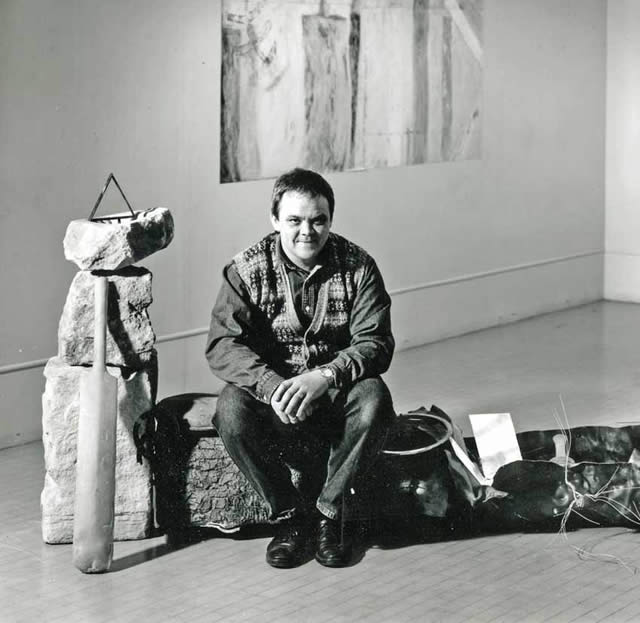| Rob Ward |
|||
Poetry of the Visible—Rob Ward's Arts
|
|||
|
|||
| Rob Ward is a prolific British artist. In his career spanning forty years, the stock in trade tools of his profession have become the images and forms in his work in which he explores spatial relationships, colour,balance and tension. Ward explores the nature and significance of "objects"in daily use, and uses notions of "fields’. In addition, He captures the essence of things in the subconscious, bringing humourand comedy to an Oriental temperament and poetic. Ward begins his habit of working in defined series: “My practice continues to take the form of chapters in a developing process, each set of work or exhibition being ameditation and integration into the mechanisms and poetry of the visible”,“For me the drawings are poems; the sculpture is novelistic”. To understand the art of Rob Ward, we have to trace back his education and art practice. |
|||
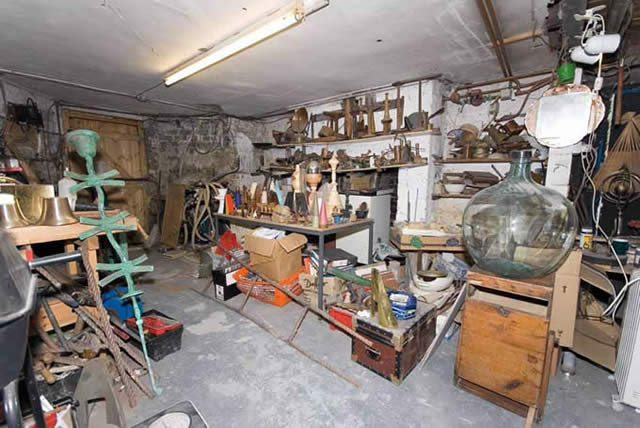 Ward's Workshop in Leeds: A number of found objects |
|||
| Education and Culture Rob Ward was born in1949 in Nottingham U.K.He studied at the University of Newcastle-upon-Tyne(1969-73).Ward's original ideal was to become a painter, in his third year Ward opted to specialise in sculpture, and decided to make art his career. He was recommended to the University of Reading for a master's degree (1973-75). On graduating he won a Greek Government Scholarship and an Italian Government Scholarship to study at Rome Academia di Belle Artiand Athens Poytechnion (1975-76).Subsequently,he moved to Australia for 5 years, and return to the United Kingdom in 1982. He has been engaged in sculpture education and art creation. Important to his education was the impact of the Bauhaus-inspired Basic Design Course programme taught at Kings.The programme eschewed traditional teaching methods such ascopying, and instead revolved around responding quickly and instinctively, to solving problems with intuition,and deconstruction. There was an emphasis on nature and organic growth, as well as ideas around mathematics and spatial exercises, which themselves led to ideas about social space. In particular here calls dismantling what he’d learned about art at school; of his changing perceptions and understanding that art was not just about facility, but about how well you can answer a question,and about asking questions of yourself. |
|||
| Art Pratice | |||
| ◤1970S Early Work For a time, in 1973 and 1974, Ward explored pure abstraction by making assemblages of hot rubber casts of water splashes.Ultimately,for him, the idea of abstraction“becoming so subjective that you can’t get hold of it” was unsatisfactory and he felt impelled to get back to working with objects and things.The question was how to keep the sculptural language going, and also how to constantly renew it through examination of the object.In this process,Ward is often mindful of Brancusi. The idea of holding an object in space, which involves consideration about plinths,scale and proportion, volume, and the interaction with space; considerations which have formedthe core of Ward’s work for more than three decades. “The sole purpose of sculpture is neither description nor imitation but the creation of unknown beings from elements which are always present but not apparent.”Duchamp-Villon. It was through Michel Foucault’s books ‘Madness and Civilisation’ and ‘The Order of Things’that Ward came to recognise the psychotic mental state that could develop in abstract artists and which drew him to look again at the world of things and to reintroduce the object into his work. |
|||
 The Well 1975 Concrete Plaster , Wax , Found Bucket |
|||
| The items used in daily such as bucket, ladder, table, chair and candlestick, are often seen in Ward’s sculptures.In his early works, he transformed the sculpture tools and materials into the images or forms of his works,contained a symbolic meaning. For example, bucket was one of the mostordinary, everyday things in Ward’s life; as a student he worked as a plastere rand the bucket was also a domestic item in addition to being an intrinsically practical item for an artist. So it symbolises ordinariness, but more importantly it is ordinariness; it is object. | |||
 Story of a Sculpture 1975 Wood, Stone, Wax, Bronze, Plaster, Found Objects |
|||
| His works fromthe seventies are assembled from natural media:wood,plaster, wax, stone, bronze. Of course they are sculptors’ materials,pregnant with association and symbolic of sculptural tradition, but presented and combined here in ways which underscore their material richness and inherent practical and aesthetic qualities. | |||
 Kiss 1975 Wax Panels, Wood, Wax, Plaster Bucket |
|||
| ◤ Australia (1977-1983) | |||
| Australia presented yet more sensory stimuli and experiences, freedom and space, warmth, wearing fewclothes, the beach and ocean, living in a large house with a very decent income, having an abundance of food and friends and fun. Life seemed good, although Ward never lost a hankering for making his mark in Europe,where at that time culture was more seriously considered. The sculptural works made in Australia, while employing similar materials and being immaculately ordered and considered, are also more fluid and more expansive than those made previously. Still Life (1979) was the first work made in Australia. A number of foundobjects – a fish slice,sculptor’s wedge, a piece of silver, an Indian club, a water sprinkler and a black cross – are carefully arranged on ashelf, while around them aluminium panels, inscribed with drawings of the same objects in motion, career around the space so that a dynamic sense of movement is created. |
|||
 Still Life 1979 Mixed Media |
|||
| By this time Ward was an avid collector of things – fans,bottles,flasks, cones, decorators’ plumbs – shapes andobjects that somehow resonated with him and which somehow had their own integrity as shapes and practical objects. They were not symbolic, as such, but significant and contained the possibility of contributing to his work. Another important development in Australia was Ward’s discovery of a ceramic-coated paper called Kromecoat. This material enabled him to inscribe it with needles and othertools, rub charcoal and pigment into it, to sandpaper back and to generally manipulate it. The pure acrylic pigment he used would bleed into the scratched paper or sit on top of the ceramic coating, creating a very rich textured surface; a perfect ground for an artist who strives to pull the surface back out into space, and to push space back beyond the surface. It’s a paper that he continues to use and drawing is a vital part of his practice, playing a role within the sculptural work, and also alongside it as an entity in its own right. |
|||
 Australia 1979 Watercolour Graphite on KC Paper |
|||
| ◤England and Hebden Bridge(1983-1989) | |||
| Ward’s work is characterised by the way in which he establishes exhibitions or projects and then makes a body of work in response to that opportunity, or in responseto his living conditions. While working at Hull and commuting between the college and Darlington,his work became smaller in scale, less expansive and more prone to drawing. A highly significant exhibition of drawings of 1977-87 and Epiphany drawings and sculpture of 1988-89, organised by the Henry Moore Centre for the Study of Sculpture, was held at Leeds City Art Gallery in 1989, following a residency on the flat roof of the gallery. |
|||
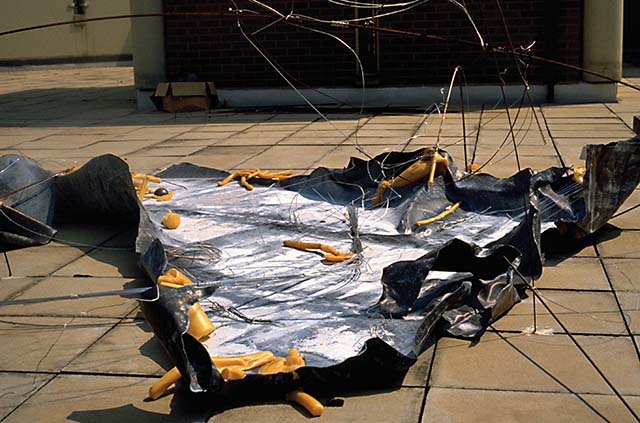 On The Roof 1989 Wax, Lead, Steel Installation |
|||
| The gallery exhibition presented a retrospective of drawings and gave Ward the opportunity to make a new body of sculpture in circumstances that were considerably more favourable than of late. | |||
 Epiphany 2 1988 Stone, Wood, Bronze, Steel, Water |
|||
| ◤1990s | |||
| The Crimsworth drawings series were a group of sixteen drawings resulting from Ward’s response to the landscape and ideas generated by his daily walks around Crimsworth, near to his home in Hebden Bridge. In Zen-like disciplined fashion,Ward set himself the task of making one drawing each week, a meditative process in itself resulting in reflective,harmonious works which have less to do with his emotional process, than a sorting of memory, of light and of colour.He said he likes “the thinking time of how the poetry comes together”,and certainly these are visual poems that have come about through the pace and rhythm of walking in a familiar landscape.“I’ve always seen what I do as a kind of visual poetry. I like the word beauty. I like the word poetry.” | |||
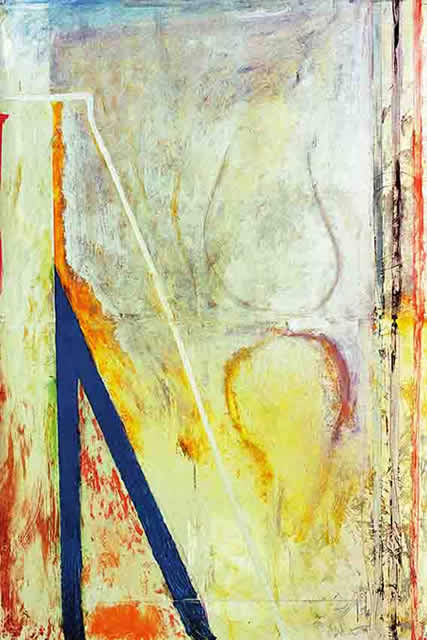 Crimsworth Stile 1996 Acrylic on KC Paper |
|||
| Ward held another major exhibition in 1998, at Bennington College in Vermont entitled ‘Songs’. Once more, the exhibition comprised a series of pairings, this time variously-sized drawings, principally with bronze-cast found and made objects, but also including glass shelves,water, wood, paper, leather and stone. Each work is a song, usually dedicated to a significant person intheartist’s life – his family and friends – or responding to another song or text or place.In part due to the sense of a personality being introduced to each work because of their titles, there is a distinct dialogue between drawing and object and their sculptural space is extensive (once again approaching the idea of theatre), thereby drawing the viewer into the space,the dialogue and completing the artwork. | |||
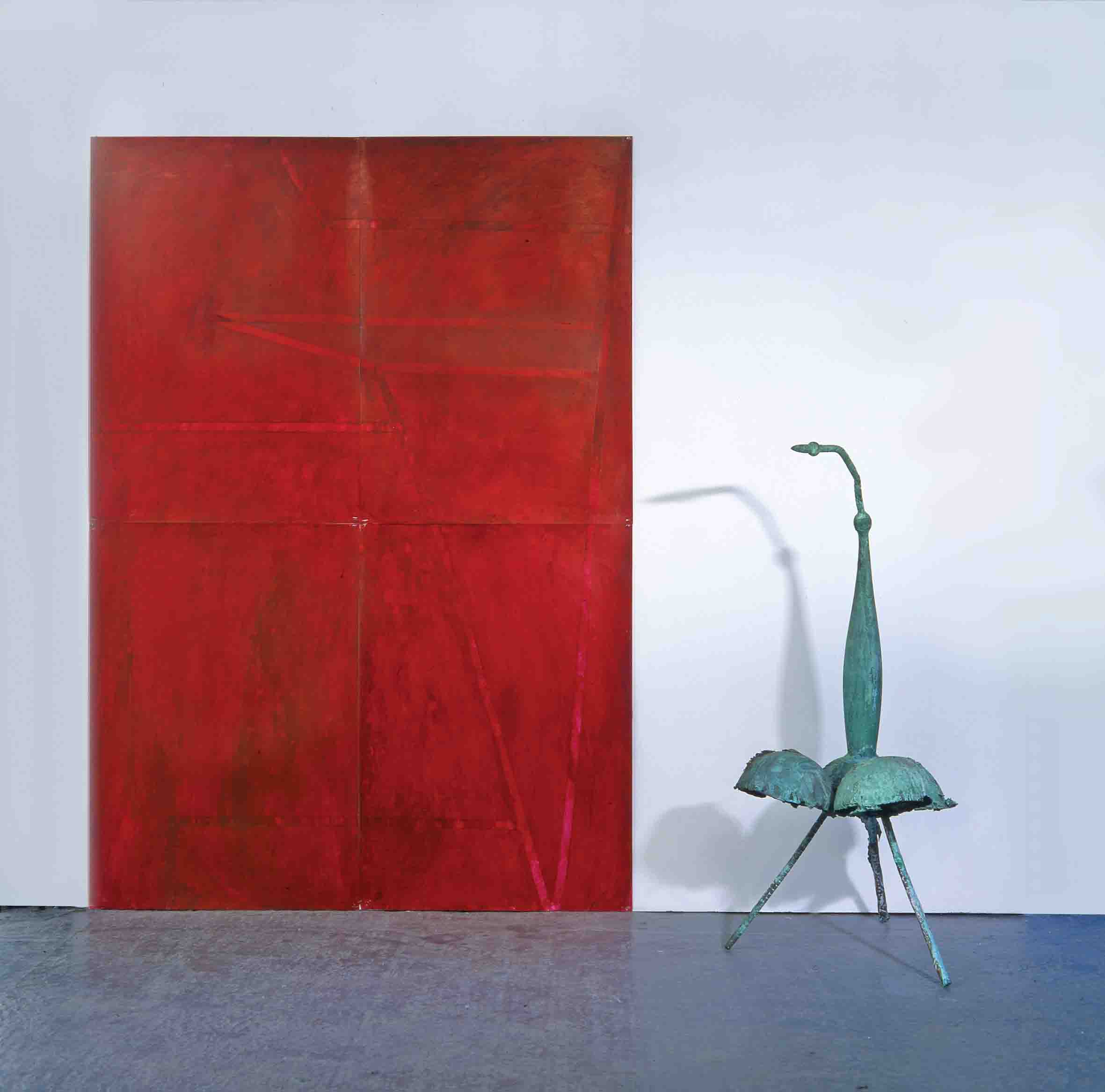 Billy's Song 1998 Acrylic on Ceramic Coated Paper, Bronze |
|||
| ◤2000s | |||
| The period since the turn of the millennium has been extraordinarily prolific for Ward. His promotion to Head of the Centre for Sculpture at Bretton Hall, University ofLeeds meant he had less direct teaching and allowed himto arrange his time differently,enabling him to produce ambitious new work. Commissions and exhibitions in theUK, Italy, China and Taiwan were also the catalyst for making outdoor works,some on a monumental scale, and a development of his practice that has informed his studio work. In 2000, Ward was invited to Guilin Yuzi Paradise International Sculpture Symposium, and started his art practice in China. | |||
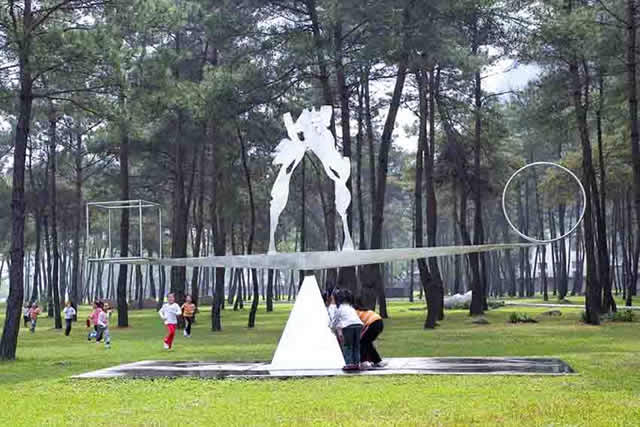 Philosophical Sculpture 2000 Stainless steel Guilin Yuzi Paradise |
|||
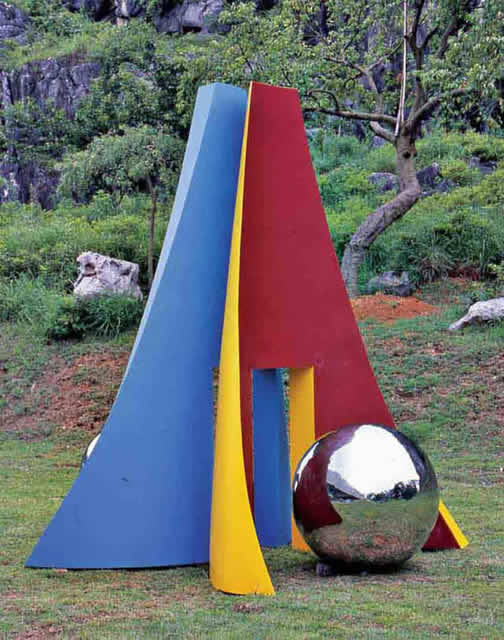 Striking Red 2005 Stainless steel Guilin Yuzi Paradise |
|||
 Theatre 2004 Granite Stainless steel Taiwan Chin Pao San |
|||
 Flower 2006 Bronze Shanghai Sculpture Park |
|||
 Pattern for Rope Tricks: Ward collected objects of balloon, rope, hoop, leaves to creat a dramatic scene |
|||
 Rope Tricks 2011 Bronze Shanghai Yuehu Museum of Art |
|||
| This recent period has seen Ward work with bronze and wood, but most particularly with stainless steel and marble.Constantin Brancusi was the first to establish reflective sculptural surfaces in an art context.The novel use of polished bronze or brass in his work resulted from his endeavour to transform the weight and tactility of sculpting materials into an ultimately visual event that approaches the ideal or essence of a subject-matter without reproducing it.Rob Ward repeatedly admitted to Brancusi as an important influence, but that alone is not an exhaustive explanation for his recent stainless steel sculptures.Highly polished reflective surfaces are the common attribute of the group of stainless steel sculptures. At first glance, the use of reflective surfaces may seem a decorative feature. But in Rob Ward’s case,it is the conscious and consistent continuation of central topics in his work:The relationship between the sculpture and its surroundings, the use of colour and pictorial elements in his objects and installations as well as the observer’s participation in the work’s genesis. | |||
 Ducks, Leather and Bells 2004 Bronze Waiblingen Germany |
|||
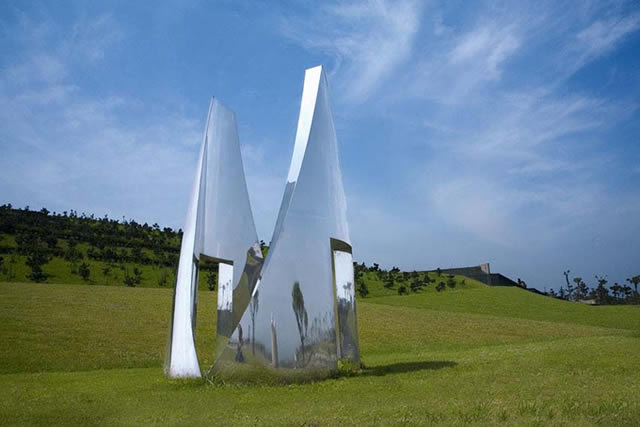 House 2004 Stainless steel Taiwan Chin Pao San |
|||
 Palace 2005 Stainless steel Florida U.S.A. |
|||
 Gate 2007 Stainless steel London U.K. |
|||
 Chapel 2010 Stainless steel, Marble Shanghai Sculpture Park |
|||
| Patterns is a show of thirty new works by Rob Ward in 2005 in Italy and Germany. The title refers to both material objects and to abstract rhythms of working and thinking that Ward has developed and refined during his career. A pattern is essentially a design or plan for something to be made but also the organization of forms (or perhaps ideas and processes)in a repeated sequence. Important to both senses of the word is the idea of relationship – the relationship of the plan to the realised form, or of one element in a sequence to another. Indeed Ward’s new works are primarily about relationships of various kinds; in particular formal, spatial, emotional and imaginative. | |||
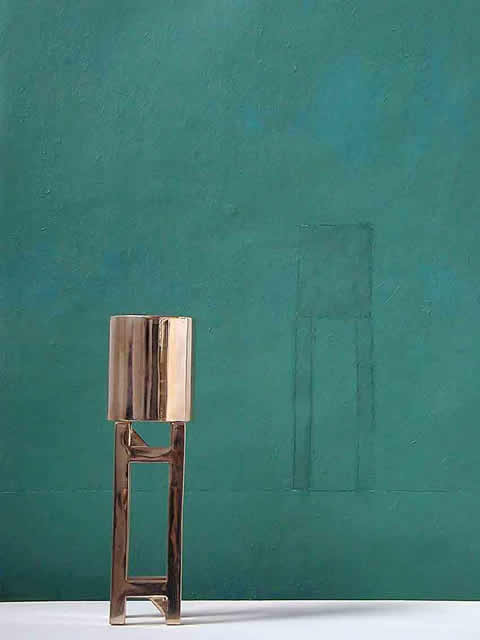 Water Tower 2003 Polished Bronze |
|||
|
|||
 Gates of Paradise 2003-4 Polished Bronze |
|||
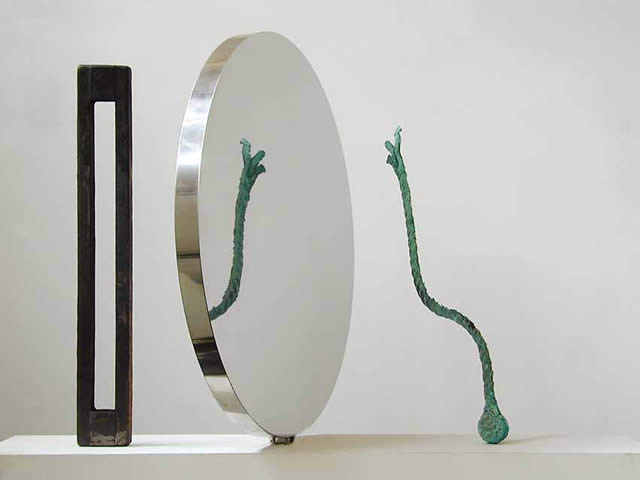 3 Definitive Ideas for Sculpture in Landscape 2004 Cast Iron Patinated Bronze, MDF and Stainless steel |
|||
copyright 2010-2011 shanghai sculpture park all rights reserved 上海余之乐实业有限公司 版权所有
沪 ICP备07017761号-1
![]()
